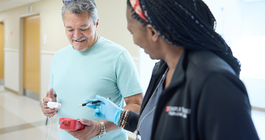
February 28, 2023
Blood has many functions and circulates throughout your body. As a result, problems with it can affect you in many ways. Some of those problems can stem from a blood disorder.
These disorders can range from mild to life-threatening. Fortunately, they can usually be managed with treatment. That’s why you should know their symptoms and see a doctor if those symptoms occur.
Blood has four components — plasma, red blood cells, white blood cells, and platelets.
A blood disorder can affect one, or all, of your blood’s components, preventing them from functioning properly. Many blood disorders are inherited, but they can also be caused by diseases, nutrient deficiencies, or side effects from medicine.
The most common non-cancerous blood disorder is anemia. If you have anemia, your blood is not supplying enough oxygen throughout your body.
Anemia can cause you to feel tired, dizzy, irritable, and cold. It can also leave you short of breath or give you a headache.
The condition is usually caused by a lack of iron, which your body needs to make hemoglobin. Other causes include blood loss, an insufficient production of red blood cells, and a high rate of red blood cells being destroyed.
Anemia can be inherited or acquired.
• Inherited anemias include sickle cell anemia, which is a form of sickle cell disease, and thalassemias, which affect your body’s ability to produce hemoglobin and healthy red blood cells.
• Acquired anemias include pernicious anemia, which prevents your body from absorbing vitamin B12; and normocytic anemia, which happens when you have a shortage of red blood cells.
Doctors use physical exams and blood tests to diagnose anemia. Treatment depends on the type of anemia you have, and can range from taking supplements or medication, to receiving a blood transfusion.
Blood clotting disorders cause your body to form blood clots easier than it should. Treatment usually includes blood thinners and anticoagulants.
Left untreated, blood clotting disorders can cause deep vein thrombosis, which occurs when a blood clot forms deep in a vein located in your legs, arms, pelvis, liver, kidneys, or intestines. If these blood clots break free and travel to your lungs, they can cause a pulmonary embolism, a life-threatening condition that requires emergency medical intervention. Blood clots can also cause heart attacks and strokes.
Symptoms of deep vein thrombosis include pain, swelling, and purple, red and/or warm skin around the affected area. Chest pain, shortness of breath, rapid heartbeat, coughing, and fainting are signs that a pulmonary embolism may have occurred.
Bleeding disorders affect your body’s ability to control blood clotting. This type of blood disorder can cause heavy bleeding from an injury or after surgery. Bleeding can also occur in your organs, muscles, and joints.
Genetically transmitted bleeding disorders include hemophilia, which is well-known but rare, and von Willebrand disease, which is common. Symptoms of both disorders can include easy bruising, heavy menstrual periods, and frequent nosebleeds.
Your blood contains proteins, called clotting factors, that help to control bleeding. Healthcare providers treat hemophilia by boosting clotting factor levels or replacing missing clotting factors. They also may give patients antifibrinolytic agents, which keep blood clots from breaking down.
Treatment for von Willebrand disease may include a drug called DDAVP (desamino-8-arginine vasopressin), although it doesn’t work for every kind of the disease.
Eosinophilic disorders involve a type of white blood cell — called an eosinophil — that helps your body respond to allergic reactions, asthma, and parasitic infections. A very high number of eosinophils may inflame your tissues and cause organ damage. The symptoms of this depend on the organs it affects. Treatment for it frequently includes oral corticosteroids.
With treatment, most non-cancerous blood disorders can be managed. But to be treated, first they must be diagnosed. That’s why it’s important to familiarize yourself with the symptoms and make an appointment with your primary care physician if you are experiencing anything concerning. Your doctor may then refer you to a hematologist for diagnosis and treatment.